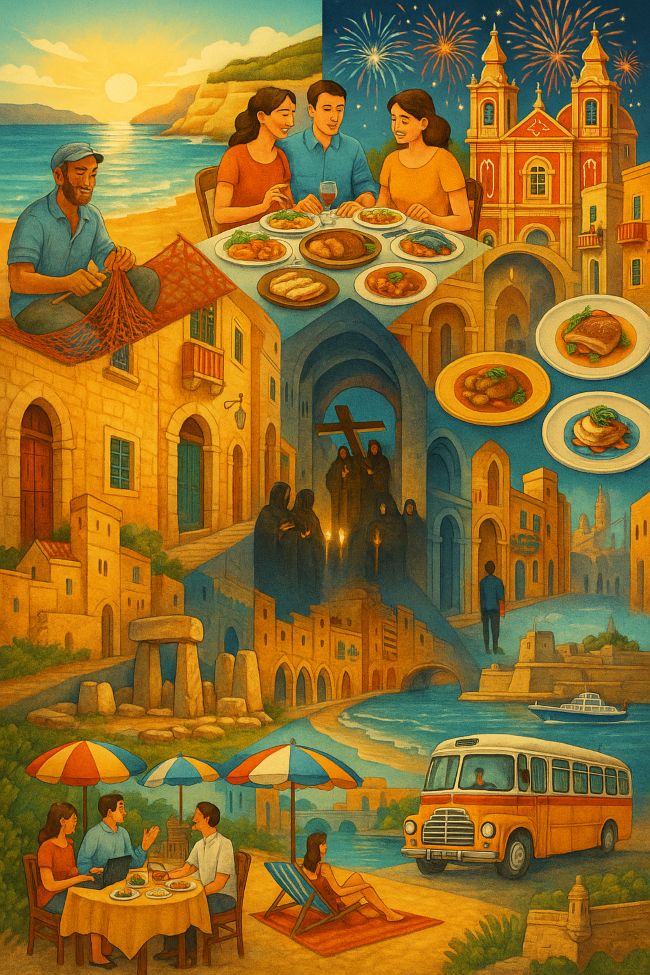| Malta Short Let: Cozy Stay in Gzira | |
|
Sliema Area Modern Designer Finished 2 Bedrooms + Games Room. First floor with Maltese Balcony Large back Terrace with swinging sofa Fully Airconditioned + Full Kitchen 3 TVs, including 65” with backlight. |
 |
|
Book Now: Google Travel | Direct (Cheapest) | Booking.com | Airbnb |
|
Fresh evidence from the 2025 State of the Nation Survey shows Malta is as resilient as it is radiant. The numbers explain the mood while the islands add the magic. Each item below anchors a survey finding to what you will feel on the ground.
1. Happy Wake-ups
Gozo tops the well-being chart: 82.8 percent of people there say they start the day in a good mood, and the rest of Malta is not far behind at 72 percent. This isn’t just statistics—it’s the fisherman whistling as he mends nets at Marsaxlokk, the baker who greets dawn customers with genuine enthusiasm, and the office workers who actually mean it when they say “good morning” at the Sliema ferry terminal.
The survey confirms what visitors quickly discover: Maltese mornings carry an infectious optimism that makes even early flights worth catching. Experience this joy yourself in Gozo’s hidden beaches or the changing beauty of San Blas.
2. Contentment almost Everywhere
A solid 72.1 percent of Maltese adults report that they are satisfied with life. You can sense it in the relaxed chatter at Gzira, Sliema and Valletta’s open-air cafes, where businesspeople linger over espresso instead of rushing back to desks.
Learn more about why Malta is important in today’s world.
3. Family-First Choices
Seventy-six percent consult relatives on big decisions. Expect restaurant owners to share grandmother’s recipes and shopkeepers to learn your name. This family-centric approach extends beyond blood relations—regular customers become honorary cousins, hotel guests receive invitations to christenings, and lost tourists find themselves adopted for afternoon tea.
Watch families gather for Sunday lunch at waterfront restaurants at the Valletta waterfront, in Mgar’s typical Maltese restaurants on the Gzira promenade or in Marsascala, tables groaning under platters of timpana and rabbit stew, conversations flowing between three generations without anyone checking their phone.
Try making traditional Maltese pastizzi to understand the love that goes into local cuisine.
4. Village Festas
Almost every summer weekend brings a festa, but Santa Marija in mid-August steals the show with bands, fireworks, and confetti that never seems to land. The survey ranks these celebrations as Malta’s most treasured cultural element, and one evening explains why.
Brass bands battle in friendly competition, statues sway through streets on shoulders of devoted carriers, and entire villages transform into open-air parties where tourists become participants, not spectators.
The festa of St. Lawrence in Birgu offers a more intimate experience, while Mqabba’s fireworks display rivals any professional show. Check our calendar of cultural events to time your visit perfectly.
5. Holy Week Reverence
Quiet candlelit processions weave through Mdina and Rabat. Even non-believers feel the pull of drums and incense. The survey shows these rituals rank equally with festas in cultural importance, revealing Malta’s dual nature—explosive joy balanced with profound solemnity.
Good Friday sees hooded penitents carrying life-sized statues through silent crowds, while Easter Sunday erupts in celebration.
Zebbug’s processions offer authenticity without overwhelming crowds, perfect for photographers seeking dramatic shots of faith in action. Discover more about Malta’s religious history.
6. Tech-Savvy Yet Social
Eighty percent of 16-to-25-year-olds are active on social media, yet 73 percent still prefer a face-to-face chat. Sip espresso in a WiFi-rich cafe overlooking a 5,000-year-old temple and see both worlds meet. Young Maltese entrepreneurs run Instagram-worthy restaurants while maintaining the personal touch—they’ll remember your dietary restrictions and ask about your day. Co-working spaces in renovated Valletta palazzos buzz with digital nomads, yet lunch breaks stretch long because networking here means actual conversation, not just LinkedIn connections. Remote workers find Malta ideal for balancing productivity with Mediterranean living.
7. Rights and Safety
Sixty-four percent feel their rights are well protected, and street crime remains low. Late-night strolls along Valletta’s Republic Street feel carefree. Women walk alone after midnight without worry, elderly couples leave doors unlocked in village cores, and lost wallets find their way back with contents intact.
This security stems from tight communities where everyone knows everyone—a social fabric that naturally deters crime while embracing newcomers who respect local ways. Learn more about Malta’s safety record for travelers.
8. Youthful Optimism
More than 75 percent of under-35s believe tomorrow will be better, and 79 percent say Malta is headed in the right direction. This isn’t naive hope—it’s grounded in visible progress. Young Maltese are opening innovative restaurants, launching tech startups from converted knights’ halls, and finding ways to honor tradition while embracing change.
Visit Is-Suq tal-Belt food market to see this generation’s vision: local ingredients, global techniques, sustainable practices, all under one gorgeously restored roof. Explore Malta’s evolving economy to understand this optimism.
9. Living Heritage
On these rocks stand temples older than Egypt’s pyramids. History is not an exhibit; it is a neighbour. The Hypogeum’s underground chambers still echo with 5,000-year-old acoustics, while Hagar Qim and Mnajdra frame perfect solstice sunrises.
But heritage lives beyond monuments—it’s in the ftira baker using the same wood-fired oven for decades, the lacemaker in Gozo keeping bobbin traditions alive, and the festa statue restorer whose grandfather taught him the craft. UNESCO sites share neighborhoods with hardware stores, proving preservation and daily life can coexist. Visit Ggantija temples for an even deeper dive into prehistory.
10. Culinary Contrast
From humble rabbit stew to Michelin-star plates with sea views, Malta pairs old flavours with new technique. The survey doesn’t capture taste, but visit Noni or De Mondion for proof of culinary evolution. Yet tradition holds strong—seek out Tal-Petut in Birgu for fish soup that hasn’t changed in generations, or join locals at Crystal Palace in Rabat for horse meat delicacies. The national dish remains fenkata (rabbit), best enjoyed at farm-to-table spots like Ta’ Soldi in Mgarr, where recipes pass through families like heirlooms. Explore Malta’s complete food guide for more culinary adventures.
11. Seamless English
Maltese and English share official status, so directions come easy, but small gestures—an extra pastizz, a bus driver’s wink—do the real greeting. The survey shows younger generations switch between languages mid-sentence, creating a linguistic flexibility that welcomes visitors while preserving identity. Signs appear in both languages, menus need no translation, yet learning “grazzi” (thank you) and “sahha” (goodbye) opens doors that English alone cannot.
Language here is bridge, not barrier. Learn more about Malta’s unique position as a bilingual nation.
12. Balanced Pace
Yes, shops shut for siesta and August crowds can swell, but that is the cue for gelato in a shady cove. The survey reveals a population that plans life carefully yet lives day-to-day—a paradox that makes perfect sense once you experience a Maltese afternoon.
Banks close at 2 PM, frustrating until you realize everyone’s at the beach. Construction noise starts early, but workers break for proper breakfast. Life runs on island time, where efficiency means knowing when not to rush. Discover the best beaches in Malta for your siesta escape.
13. Growing Pains
Housing costs, traffic in early mornings, and some cranes filling the skyline show an economy in motion—real challenges the islands tackle with trademark grit. The survey acknowledges what’s obvious to any visitor: Malta is changing fast.
Traditional houses make way for apartments, and morning traffic rivals any European capital. Yet 47 percent expect life to improve, suggesting faith that growth can be managed. Smart visitors avoid rush hours, explore beyond hotspots, and understand that progress here means preserving what matters while adapting what must. Learn about Sliema’s transformation from fishing village to modern hub.
14. Island Resilience
Maltese people have outlasted Ottoman sieges, French occupation, Axis blitzes in World War II, and more. The survey finds a population ready to face future tests with the same steady resolve. This isn’t ancient history—talk to any local over 60 about rationing, bomb shelters, and rebuilding. The War Museum at Fort St. Elmo tells these stories, but resilience shows in smaller ways: how businesses pivoted during COVID, how communities support struggling neighbors, how optimism persists despite global uncertainties.
Maltese grit comes wrapped in hospitality, making challenges seem surmountable. Explore Malta’s strategic role in WWII, life on a fortress island during WWI, and the complete history of sieges and survival. Learn about the Great Siege of 1565, when the Knights of Malta defended these islands against overwhelming odds, or discover how the Three Cities sustained Malta during countless battles. The military tactics used during the Great Siege still inspire military historians today, while the Ottoman Empire’s rise provides context for Malta’s pivotal role in European history. Even the economics of survival tell a story of resourcefulness that echoes in today’s entrepreneurial spirit.
15. Travel Tips and Deals
Book September to November and January or February for mild weather and lower short-term rates before carnival season kicks off. Need a base? Airbnb options abound, with a two-bedroom apartment a short stroll from the Gzira promenade at Manicmalta.com/gzira offering fast WiFi, 2 min walk from the sea, and bus links across the island.
Grab a bus pass, or rent a compact car to reach those hidden coves. The Tallinja card covers all public transport; buy it at the airport for convenience. For dining, book ahead at popular spots like Rubino or Sciacca Grill, but leave some evenings open for spontaneous discoveries. The ferry to Gozo runs frequently—don’t just daytrip, spend a night to feel the smaller island’s distinct rhythm. Check out our complete Malta travel guide and packing list for more essential tips.
Conclusion
From dawn happiness scores to firework-lit festas, Malta offers proof that joy can be a daily practice. Resilient through sieges and wars, yet forward-leaning in tech and art, the islands invite you to share in their next chapter. Pack a hat, learn a few Maltese phrases, and see why Sunday lunch can last three hours—nobody minds, and neither will you. Ready to explore? Start with a self-guided tour of Valletta or discover 20 amazing day trips from Sliema and Gzira.








